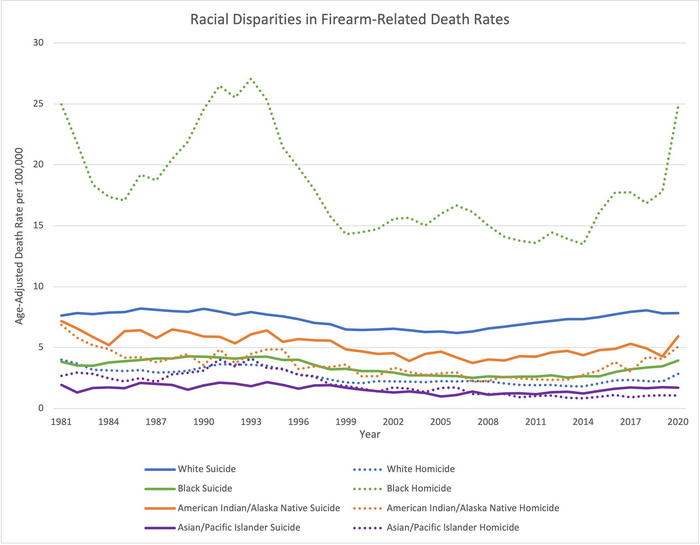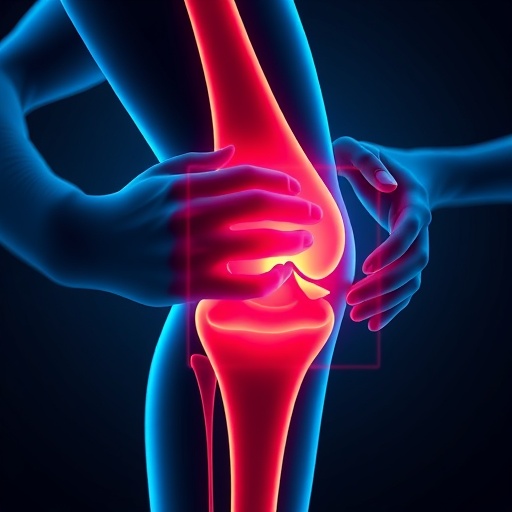A new analysis of firearm death rates from 1981 to 2020 shows that the people most heavily impacted by firearm deaths were Black men and white men, and that rates of firearm-related homicides and suicides jumped between 2019 and 2020. Lindsay Young of the University of Cincinnati College of Medicine, Ohio, and Henry Xiang of Nationwide Children’s Hospital, Ohio, present these findings in the open-access journal PLOS ONE on December 14, 2022.

Credit: Young and Xiang, 2022, PLOS ONE, CC-BY 4.0 (https://creativecommons.org/licenses/by/4.0/)
A new analysis of firearm death rates from 1981 to 2020 shows that the people most heavily impacted by firearm deaths were Black men and white men, and that rates of firearm-related homicides and suicides jumped between 2019 and 2020. Lindsay Young of the University of Cincinnati College of Medicine, Ohio, and Henry Xiang of Nationwide Children’s Hospital, Ohio, present these findings in the open-access journal PLOS ONE on December 14, 2022.
In the U.S. firearms are involved in 60 percent of suicides and 36 percent of homicides. Understanding historic trends and disparities in firearm death rates is necessary to inform efforts to reduce deaths. However, most previous research on firearm death trends has focused on relatively short timelines or considered homicide or suicide alone.
To gain new insights into firearm death trends, Young and Xiang analyzed U.S. firearm death rate data collected between 1981 and 2020, comparing rates between racial groups and sexes. They sourced the data from the Centers for Disease Control and Prevention (CDC)’s WISQARS database for fatal injury and violence.
The researchers found that Black people were most heavily affected by firearm homicide. Firearm homicide rates for Black people were nearly seven times those for white people. Between 2019 and 2020, firearm homicide deaths spiked, and this increase was largest for Black people, at 39 percent. Homicide rates for men were five times higher than for women.
Firearm suicide rates were highest for white people, and for all racial groups except Asian/Pacific Islander, and suicide rates rose between 2019 and 2020. The suicide rate for men was seven times higher than the suicide rate for women.
Between 2011 and 2020, minority populations were most heavily impacted by homicide and suicide in terms of years of potential life lost before age 75—a measure reflecting premature death.
These findings suggest that efforts to prevent firearm suicides and homicides should account for the demographics of people most impacted. The researchers also note that their study highlights the urgency of such efforts and that dismantling structural racism in the U.S. is necessary to address the disparities they found.
The authors note that “over the past 4 decades, firearm injuries disproportionally affect[ed] certain demographic groups in US society,” and add: “United States must treat violence and firearm-related injuries as [a] national health priority.”
#####
In your coverage please use this URL to provide access to the freely available article in PLOS ONE: https://journals.plos.org/plosone/article?id=10.1371/journal.pone.0278304
Citation: Young LJ, Xiang H (2022) US racial and sex-based disparities in firearm-related death trends from 1981–2020. PLoS ONE 17(12): e0278304. https://doi.org/10.1371/journal.pone.0278304
Author Countries: USA
Funding: The author(s) received no specific funding for this work.
Journal
PLoS ONE
DOI
10.1371/journal.pone.0278304
Method of Research
Observational study
Subject of Research
People
Article Title
US racial and sex-based disparities in firearm-related death trends from 1981–2020
Article Publication Date
14-Dec-2022
COI Statement
The authors have declared that no competing interests exist.




